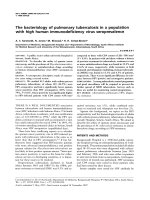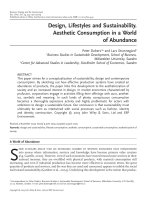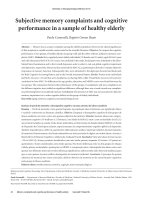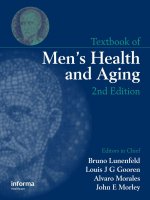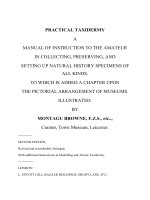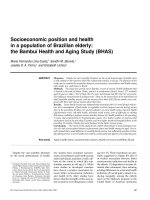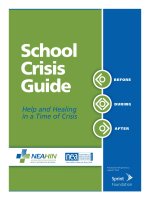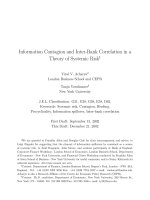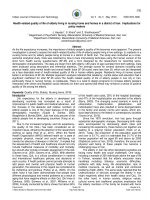Socioeconomic position and health in a population of Brazilian elderly: the Bambuí Health and Aging Study (BHAS) pdf
Bạn đang xem bản rút gọn của tài liệu. Xem và tải ngay bản đầy đủ của tài liệu tại đây (99.32 KB, 8 trang )
Socioeconomic position and health
in a population of Brazilian elderly:
the Bambuí Health and Aging Study (BHAS)
Maria Fernanda Lima-Costa,
1
Sandhi M. Barreto,
1
Josélia O. A. Firmo,
1
and Elizabeth Uchoa
1
Objective. Despite the vast scientific literature on the social determinants of health, there
is still a debate on the extent to which this relationship remains in old age. The objective of this
study was to examine the association between socioeconomic circumstances and health among
older adults in a small town in Brazil.
Methods. The study was carried out in Bambuí, a town of around 15 000 inhabitants that
is located in the state of Minas Gerais, which is in southeastern Brazil. From 1 177 residents
aged 65 years or older, 1 074 of them (91.2%) were interviewed and 997 (84.7%) were exam-
ined (physical measurements and blood tests). Those in the lowest third of the distribution of
total household monthly income, with an income of less than US$ 240 per month, were com-
pared with those who had an income above that level.
Results. Lower family income was independently associated with: (1) some lifestyle risk fac-
tors (less consumption of fresh fruits or vegetables and less frequent exercise during leisure
time in the preceding 30 days), (2) several indicators of worse health status (General Health
Questionnaire score, self-rated health, self-rated visual acuity, level of difficulty in walking
300 meters, inability to perform routine activities because of a health problem in the preceding
2 weeks, and seropositivity for Trypanosoma cruzi), (3) a higher number of nonprescribed
medications used in the preceding 3 months, and (4) a higher number of hospitalizations in the
preceding 12 months. Obesity was more frequent in the higher-income group.
Conclusions. The results of this study do not confirm observations in some developed coun-
tries of a lack of association between socioeconomic status and health among the aged. Our re-
sults showed that a small difference in monthly family income was sufficiently sensitive to iden-
tify elderly persons in worse health, even within a community that appears to be uniformly poor.
Aged, health status, socioeconomic factors, health services accessibility, Brazil.
ABSTRACT
Despite the vast scientific literature
on the social determinants of health,
few studies have examined socioeco-
nomic circumstances and health among
older individuals, and there is still a de-
bate on the extent to which this rela-
tionship remains in old age (1). While
some studies in developed countries
have shown a positive association be-
tween better socioeconomic indicators
and health (2–9), other studies have
shown that the strength of this associa-
tion is small or even disappears in older
age (10–17). Three hypothesis are gen-
erally suggested to explain the lack of
or weaker association between better
socioeconomic indicators and health in
the elderly: (1) disparities in income di-
minish after retirement, thus reducing
existing differences in social and health
indicators; (2) social policy aimed at re-
ducing inequality among the elderly
(such as the Medicare program in the
United States of America) minimizes
Rev Panam Salud Publica/Pan Am J Public Health 13(6), 2003 387
Key words
1
Fundação Oswaldo Cruz and Universidade Fed-
eral de Minas Gerais, Núcleo de Estudos em Saúde
Pública e Envelhecimento (NESPE), Belo Hori-
zonte, Minas Gerais, Brazil. Send correspondence
to: Maria Fernanda Lima-Costa, Núcleo de Estu-
dos em Saúde Pública e Envelhecimento, Centro
de Pesquisas René Rachou, Fundação Oswaldo
Cruz, Av. Augusto de Lima 1715, 30 190 002, Belo
Horizonte, MG, Brazil; e-mail: lima-costa@cpqrr.
fiocruz.br
differences in access to quality care,
with a reflection in health conditions;
and (3) survival bias (premature mor-
tality among lower-income people)
and/ or selection due to attrition (insti-
tutionalized individuals do not partici-
pate in population-based studies) (7).
Social inequalities have increased
worldwide, especially in developing
countries. Inequalities are particularly
severe in the Region of the Americas,
with Brazil, Guatemala, and Paraguay
ranking respectively second, third,
and fourth in the world in terms of in-
come concentration (18). The older
population is growing very rapidly in
developing countries. Recent projec-
tions indicate that between 1990 and
2025 the population aged 60 and older
will increase some seven to eight times
in countries such as Colombia, Ghana,
Kenya, Malaysia, and Thailand. Five
of the 10 countries with the largest
older populations in the world by 2025
will be developing countries. One of
those 10 is Brazil, which will have
some 27 million people over age 60 in
2025 (19). There is a growing concern
regarding the rapid increase of the
aged population in Brazil and other
countries with great socioeconomic in-
equalities. However, the effects of so-
cioeconomic circumstances on the
health of the elderly in Brazil and in
other developing countries have not
been thoroughly investigated.
This article examines whether there
is an association between socioeco-
nomic position and health among
older adults living in a small town in
Brazil that appears to be uniformly
poor. The study examined the influ-
ence of socioeconomic circumstances
on biological, behavioral, and psycho-
logical risk factors; indicators of health
status; and use of health services and
medications.
METHODOLOGY
Study area
The subjects in this study were par-
ticipants in the baseline portion of the
Bambuí Health and Aging Study
(BHAS). The BHAS is a population-
based cohort study of older adults car-
ried out in the town of Bambuí. The
town of Bambuí is located in the mu-
nicipality of the same name, in the
state of Minas Gerais, which is in the
southeastern part of Brazil (20).
The municipality of Bambuí has
20 573 inhabitants, with 73% of them
living in the urban area of the munici-
pality, that is, the town of Bambuí. In
1996, life expectancy was 70 years (21).
The main causes of death were stroke,
Chagas’ disease, ischemic heart dis-
ease, and pulmonary chronic obstruc-
tive disease, with respective death
rates of 110.0, 61.4, 42.5, and 18.9 per
100 000. Bambuí was formerly an en-
demic area for Chagas’ disease. Be-
cause the transmission of Trypanosoma
cruzi was only interrupted around
20 years ago, the prevalence of infec-
tion among the aged remains high
due to the cohort effect, and mortal-
ity from this cause is still high in the
population.
The town has one general hospital,
with 62 beds, and a public outpatient
clinic that provides first aid services 24
hours a day. Some medications are
distributed free by the local public
health care system, but the system’s
stocks of medications are variable and
erratic. In 1996 there was one doctor
per 1 000 inhabitants in the town.
There is no institution for the elderly
in the community (20).
Study population
Our team carried out a complete cen-
sus in the town of Bambuí in Novem-
ber and December 1996 in order to
identify participants for the cohort
study. All residents aged 60 or older
were selected for participation. Of
1 742 residents in this age group, 1 606
of them (92.2%) were interviewed and
1 496 (85.9%) were examined (blood
tests, anthropometric measurements,
and blood pressure) in the baseline of
the cohort study. Participants who
were interviewed and who were exam-
ined were similar to the entire town
population in this age group in all the
characteristics investigated: age distri-
bution, gender, number of persons in
the household, conjugal status, family
income, and education (20). All of the
participants in the baseline study who
were 65 or older were selected for this
study. Interviews, physical measure-
ments, and blood tests were performed
between January and August 1997.
Interview
The following variables from the
baseline BHAS interview were consid-
ered in this study: (1) sociodemo-
graphic characteristics (age, gender,
and monthly family income); (2) social
ties (contentment with social network,
contentment with free-time arrange-
ments (when not working), and pres-
ence of an informal caregiver at home
for the elderly person when neces-
sary); (3) lifestyle risk factors (smok-
ing, consumption of fruits and/or veg-
etables, and physical activity during
leisure time), (4) mental health (insom-
nia and psychiatric symptoms); (5) his-
tory of selected diseases (asked as,
“Has a doctor ever said that you had
angina pectoris, myocardial infarction,
arthritis, or any other disease?”);
(6) other measures of health status
(self-rated health in the preceding 6
months, being unable to perform rou-
tine activities because of a health prob-
lem in the preceding 2 weeks, and
staying in bed in the preceding 2
weeks because of any disease or
chronic condition); (7) physical func-
tioning (degree of difficulty in walking
300 m; inability to perform at least one
of the following activities of daily liv-
ing: bathing, dressing, transferring
from bed to chair, using the toilet, or
eating; and visual acuity (asked as, “In
general, do you think that your sight—
with or without the help of glasses—is
very good, good, bad, very bad, or
blind?”)); (8) use of health care ser-
vices at public and/or private facilities
(visits to a doctor in the preceding 12
months, and hospitalizations for at
least one night in the preceding 12
months); (9) use of medications (num-
ber of prescribed medications and of
nonprescribed medications used in the
preceding 3 months); (10) source of
health care (private care or public sys-
388 Lima-Costa et al. • Socioeconomic position and health in a population of Brazilian elderly
tem); and (11) main complaint or dis-
satisfaction when seeking medical care
or medication (20, 22).
Monthly family income, which is the
dependent variable in this study, was
assessed by asking respondents to in-
dicate their total household income,
from everyone living in the home, be-
fore taxes. We grouped the older per-
sons into thirds, using multiples of
the Brazilian minimum wage (BMW).
(In 1997 the Brazilian minimum wage
was US$ 120 per month). The lower-
income group was defined as those
in the lowest third, whose households
were earning less than two BMWs
(US$ 240) per month.
Mental health was assessed in terms
of two characteristics, insomnia and
psychiatric symptoms. Insomnia was
defined as a complaint, for the preced-
ing 30 days, concerning difficulty in
initiating sleep, frequency of disrupted
sleep, or early morning awakening,
happening three times a week or more,
with any level of distress (23). To iden-
tify psychiatric symptoms (such as
symptoms of depression and/or anxi-
ety), we used the 12-item version of the
General Health Questionnaire (GHQ),
considering the symptoms that had oc-
curred in the preceding 2 weeks (24).
To define the presence of psychiatric
symptoms, we used a cut-off score of
≥ 4 on the GHQ. The GHQ version
used in this study was previously vali-
dated in Brazil (25).
The interviews were carried out by
individuals whom our team had se-
lected from among community mem-
bers with at least 11 years of schooling.
When a respondent was unable to par-
ticipate because of a cognitive deficit
or for some other health reason, a
proxy was used (such as another fam-
ily member in the same household or
the informal caregiver). Proxies were
not asked questions that required per-
sonal judgment such as social ties,
well-being, self-rated health, self-rated
visual acuity, and mental health (20).
Physical measurements
Blood pressure was measured 30 or
more min after the last caffeine intake
or cigarette smoked, and after at least 5
min of initial rest. Three measurements
were taken at 2-min intervals. The
blood pressure level was considered to
be the arithmetic mean of the second
and third measurements (20, 22).
Anthropometric measurements were
performed with individuals wearing
light clothes and no shoes. As we lack
population-based weight and height
parameters for the elderly population
of Brazil, underweight and obesity in
this study were considered as the mean
body mass index (BMI = weight (kg)/
height (m) squared) ± one standard de-
viation. The respective cut-off values
were 20 and 30 kg/m
2
(26).
Blood tests
Blood samples were drawn after
recommended fasting for 12 hours.
The following blood tests were consid-
ered in this study: glucose, total cho-
lesterol, HDL cholesterol, triglyceride,
and serology for Trypanosoma cruzi.
Further details are described else-
where (20, 21).
Data analysis
Data analysis was based on multiple
logistic regression (27). Age and sex
were a priori considered as confound-
ing variables in the multivariate analy-
sis. Proxy respondent was also consid-
ered as a confounding variable when
the information was based on the
BHAS interview (except for questions
that required personal judgment: so-
cial ties, self-rated health, self-rated vi-
sual acuity, insomnia, and psychiatric
symptoms). The analysis was carried
out using the Stata statistical software
(28).
RESULTS
From a total of 1 177 residents aged
65 or older, 1 074 of them (91.2 %) were
interviewed and 997 (84.7%) were ex-
amined (physical measurements and
blood tests). Among the persons inter-
viewed, 32.6% of them had a monthly
family income of < 2.0 Brazilian mini-
mum wages (BMWs) (US$ 240), 37.1%
had an income of 2.0–3.9 BMWs (US$
240 to US$ 468), and 30.3% had an in-
come ≥ 4.0 BMWs (US$ 480). (In pre-
senting the results that follow, we
compare the older residents whose
households had an income of < 2.0
BMWs (referred to as “lower income,”
“poorer,” or “poor”) with the resi-
dents whose households had an in-
come of ≥ 2.0 BMWs (referred to as
“higher income” or “better off”).
Lower monthly family income (< 2.0
BMWs) was more frequent among the
women than among the men (67.0%
and 58.2%, respectively; odds ratio
(OR) = 1.38; 95% confidence interval
(CI): 1.10–1.72). Proxy respondents
were used more frequently among
those with a lower monthly family in-
come in comparison with those who
were financially better off (9.2% and
5.8%, respectively) (OR = 1.70; 95% CI:
1.07–2.69). No significant associations
were found between family income
and age (P > 0.05).
Lower family income was associ-
ated with less consumption of fresh
fruits or vegetables and with less fre-
quent exercise. Obesity was more fre-
quent among the better off (Table 1).
Current smoking, physical activity,
systolic and diastolic blood pressure,
blood glucose, total cholesterol, and
HDL cholesterol were not significantly
associated with monthly family in-
come (all P > 0.05). Level of fasting
triglyceride was significantly associ-
ated with monthly family income in
the crude analysis (P = 0.005), but this
association disappeared after adjust-
ments for age and sex.
No associations (P > 0.05) were found
between family income and content-
ment with the social network or con-
tentment with the free-time arrange-
ments. The presence of a relative as an
informal caregiver when necessary was
less frequent among the poorer group
(83.2%) as compared with the higher-
income group (92.4%) (adjusted OR =
0.41; 95% CI: 0.23–0.72).
Table 2 shows measures of health
status significantly associated with
monthly family income. A number
of items were associated with lower
Rev Panam Salud Publica/Pan Am J Public Health 13(6), 2003 389
390 Lima-Costa et al. • Socioeconomic position and health in a population of Brazilian elderly
TABLE 1. Behavioral and biological risk factors significantly associated with monthly family income among older adults, with adjusted odds
ratio (OR) and 95% confidence interval (CI), Bambuí, Brazil, 1997
Monthly family income
< 2.0 BMWs
a
≥ 2.0 BMWs
Risk factors No. % No. % Adjusted OR 95% CI
Daily consumption of fresh fruits or vegetables
Yes 140 40.1 378 47.9 1.00
No 209 59.9 347 47.9 1.87 1.42–2.46
b
Frequency of exercise during leisure time in preceding 30 days
≥ 3 times a week 24 6.9 105 14.5 1.00
1–2 times a week 23 6.6 63 8.7 1.46 0.75–2.81
b
Less than once a week 302 86.5 557 76.8 2.17 1.36–3.46
b
Body mass index (kg/m
2
)
≤ 20 59 19.7 103 15.8 0.82 0.57–1.18
c
20.1–29.9 199 66.3 429 65.7 1.00
≥ 30 42 14.0 121 18.5 0.57 0.35–0.93
c
a
BMWs = Brazilian minimum wage multiples (one BMW = US$ 120 in 1997).
b
OR and 95% CI by multiple logistic regression, adjusted for age, sex, and proxy respondent.
c
OR and 95% CI by multiple logistic regression, adjusted for age and sex.
TABLE 2. Measures of health status significantly associated with monthly family income among older adults, with adjusted odds ratio (OR)
and 95% confidence interval (CI), Bambuí, Brazil, 1997
Monthly family income
< 2.0 BMWs
a
≥ 2.0 BMWs
Chronic diseases or health conditions No. % No. % Adjusted OR 95% CI
General Health Questionnaire score
< 4 115 36.3 328 48.0 1.00
≥ 4 202 63.7 355 52.0 1.53 1.16–2.03
b
Self-rated health
Very good/Good 57 16.3 188 17.0 1.00
Reasonable 147 42.1 338 46.6 1.30 0.89–1.90
b
Bad/Very bad 113 34.4 157 21.7 2.03 1.35–3.06
b
Self-rated visual acuity
Very good 5 1.4 23 3.2 1.00
Good 157 45.2 372 51.3 2.05 0.76–5.51
b
Bad/Very bad 185 53.3 330 45.5 2.57 1.01–6.91
b
Degree of difficulty in walking 300 m
None 162 47.0 418 57.7 1.00
Some 78 22.6 147 20.3 1.28 0.92–1.78
c
Much/Unable 105 30.4 159 22.0 1.47 1.10–2.05
c
Inability to perform routine activities because of a health problem
in preceding 2 weeks
No 217 77.6 626 86.3 1.00
Yes 78 22.4 99 13.7 1.66 1.19–2.32
c
Seropositivity for Trypanosoma cruzi
No 155 49.5 437 65.1 1.00
Yes 158 50.5 234 34.9 1.85 1.41–2.44
b
a
BMWs = Brazilian minimum wage multiples (one BMW = US$ 120 in 1997).
b
OR and 95% CI by multiple logistic regression, adjusted for age and sex.
c
OR and 95% CI by multiple logistic regression, adjusted for age, sex, and proxy respondent
.
family income: GHQ score ≥ 4, worse
self-rated health, worse self-rated vi-
sual acuity, greater difficulty in walk-
ing 300 m, inability to perform routine
activities because of a health problem
in the preceding 2 weeks, and seropos-
itivity for T. cruzi. All these associa-
tions remained after adjustments for
confounders.
Family income was significantly as-
sociated (P < 0.05) with insomnia in the
preceding 30 days, inability to perform
at least one of five activities of daily liv-
ing, staying in bed in the preceding 2
weeks, and a previous medical diagno-
sis of arthritis in the crude analysis, but
these associations disappeared after
adjustments for confounding variables.
A previous medical diagnosis of coro-
nary heart disease or other chronic dis-
ease was not significantly associated
with family income in the crude analy-
sis (P > 0.05).
Those with a lower family income
reported using a higher number of non-
prescribed medications (two or more)
during the preceding 3 months, hav-
ing more hospitalizations (two or
more) in the preceding 12 months, and
using the public system as their source
of health care (Table 3). The use of pre-
scribed medications in the preceding
3 months and the number of visits to
a doctor during this period were not
significantly associated with socioeco-
nomic circumstances (P > 0.05).
Older adults with a lower family in-
come mentioned having more difficul-
ties in paying for a medical visit, in
making a medical appointment be-
cause of existing lines, and in obtaining
medicines because of financial prob-
lems or any other problem (Table 4).
DISCUSSION
Our results demonstrate strong and
independent associations between
lower family income among the el-
derly and some biological and lifestyle
risk factors, measures of health status,
use of nonprescribed medications, and
numbers of hospitalizations.
Other studies have also indicated
that the poor elderly are less physi-
cally active, consume fewer fresh veg-
etables and fruits, and are more likely
to have a poor diet (29–31). In contrast
to developed countries (30), obesity in
the older persons in our study was
more common among those who were
financially better off. The combination
of obesity with better socioeconomic
conditions has also been found in
other developing countries. For exam-
ple, in China and India, higher income
levels, particularly in urban areas,
were also associated with obesity and
with consumption of a diet higher in
fat (30, 32). Excess weight seems to ap-
pear first among the affluent and then
among low-income groups. This pat-
tern is likely due to a combination of
reduced physical activity and a transi-
tion to a lipid-rich diet (33).
In comparison to the better-off el-
derly in Bambuí, the poorer elderly
perceived their health as being worse,
reported more psychiatric symptoms,
had worse physical functioning, and
had more difficulties in performing
routine activities because of a health
problem. With one exception, we did
not find significant associations be-
tween poverty and specific diseases or
specific chronic conditions in the
study population. That exception was
T. cruzi infection, which was more fre-
quent among the poor aged. Taken to-
gether, the health attributes that we
found to be associated with poverty
suggest that the poor elderly have a
lower quality of life. Physical function-
ing, psychiatric symptoms, and self-
rated health are more salient indica-
tors of quality of life than specific
diseases. In addition, self-rated health
and major depression have been found
Rev Panam Salud Publica/Pan Am J Public Health 13(6), 2003 391
TABLE 3. Indicators of use of health services and medications significantly associated with monthly family income among older adults,
with adjusted odds ratio (OR) and 95% confidence interval (CI), Bambuí, Brazil, 1997
Monthly family income
< 2.0 BMWs
a
≥ 2.0 BMWs
Characteristics No. % No. % Adjusted OR 95% CI
Use of nonprescribed medications during preceding 3 months
None 275 79.9 608 84.3 1.00
1 42 12.2 83 11.5 1.12 0.75–1.67
b
2+ 27 7.9 30 4.2 2.01 1.17–3.47
b
Number of hospitalizations in preceding 12 months
None 250 71.6 564 77.8 1.00
1 59 16.9 122 16.8 1.01 0.71–1.43
b
2+ 40 11.5 39 5.4 2.11 1.31–3.39
b
Source of health care
Public system 315 90.5 557 76.8 1.00
Private 33 9.5 168 23.2 0.36 0.24–0.55
b
a
BMWs = Brazilian minimum wage multiples (one BMW = US$ 120 in 1997).
b
OR and 95% CI by multiple logistic regression, adjusted for age, sex, and proxy respondent.
to be consistent predictors of mortality
among older adults (34, 35)
It is possible that health in old age
reflects the cumulative effect of a life
of restricted health care (7), and there
is some evidence that the poor aged
are less likely to receive health care de-
spite having adequate health insur-
ance (36). In the Bambuí study, the
poorer elderly reported more difficul-
ties in using health services, even
though access to health care is re-
garded as universal in Brazil. The
poorer elderly also used more nonpre-
scribed medications, were hospital-
ized more often, and reported more
difficulties in arranging medical con-
sultations and obtaining medications.
On the other hand, no differences be-
tween poor and better-off elderly were
found regarding the number of pre-
scribed medications and the number
of visits to a doctor.
As expected, the poor elderly men-
tioned financial problems more often
as the main reason for difficulties in
obtaining medications. An ethno-
graphic study carried out in this com-
munity showed that in order to deal
with this problem the poor elderly
tend to adopt strategies that can have a
negative effect on their health, such as
purchasing only part of the prescribed
medicines or reducing the dose of the
prescribed medication (Uchoa E., per-
sonal communication, 2002).
We found that the poor elderly were
hospitalized more frequently. This
might be a consequence of worse
health status, inadequate medical in-
terventions, or a combination of those
two factors. On the other hand, health
status could not explain the frequency
of visits to a doctor, which was similar
among the poorer elderly and the bet-
ter-off elderly in the study community.
On the contrary, our results indicate
that the poorer elderly have worse
health status and, as a consequence,
one could expect them to make more
doctor’s visits. Two of the problems in
having access to medical care—the
consultation fees and the long lines—
might explain this apparently contra-
dictory result.
While some studies have shown that
lower-income groups have less social
support (37, 38), another study has not
shown that (6). In our study, content-
ment with the social network and with
the free-time arrangements was simi-
lar for the poorer and the better-off el-
derly. However, having a relative as
an informal caregiver was less fre-
quent among the poorer elderly.
Regarding methodological aspects,
several steps were followed to avoid
bias in this study: collecting informa-
tion using double-blinding, assessing
the reliability of the data gathered,
standardizing procedures and instru-
ments, training of field-work and labo-
ratory teams, and adjusting for several
confounding variables. Internal valid-
ity was assured because the elderly
participants in the baseline of the Bam-
buí cohort study were similar to the
town’s entire population of aged per-
sons in terms of several sociodemo-
graphic characteristics (20). On the
other hand, given that this is a cross-
sectional study, it is not possible to
disentangle the temporal relations be-
tween economic hardship and health
status or related conditions. But it is
important to note that previous stud-
ies elsewhere have shown no evidence
of reverse causation, that is, that
episodes of illness might have caused
subsequent economic hardship (6, 14).
We used monthly family income as the
measure of economic hardship in this
study, instead of household income
per capita, because total family income
takes into account the economies of
scale in household consumption, such
as the costs of having a refrigerator
and lighting, which are somewhat the
same regardless of the number of per-
sons in the household. In addition,
studies have shown that the relation-
ship between income inequality and
mortality rates was virtually un-
changed when results were simultane-
ously adjusted for taxes, transfer pay-
ments, and household size (39). We
also preferred to use income (a charac-
teristic that can change during the life-
392 Lima-Costa et al. • Socioeconomic position and health in a population of Brazilian elderly
TABLE 4. Distribution of main dissatisfactions when seeking medical care or trying to obtain medication according to monthly family in-
come, Bambuí, Brazil, 1997
Monthly family income
< 2.0 BMWs
a
≥ 2.0 BMWs
Main complaint No. % No. % Adjusted OR 95% CI
Problems when seeking medical care
Did not report any problem 94 27.1 258 35.7 1.00
Other problem 113 32.6 244 33.8 1.22 0.88–1.69
Difficulty in making medical appointments because of existing lines 73 21.0 119 16.5 1.72 1.18–2.51
Consultation fee 67 19.3 101 14.0 1.77 1.19–2.61
Problems in obtaining a medication
Did not report any problem 132 38.0 402 55.6 1.00
Other problem 40 11.5 53 7.3 2.26 1.43–3.58
Financial problem 175 50.4 268 37.1 2.06 1.56–2.72
a
BMWs = Brazilian minimum wage multiples (one BMW = US$ 120 in 1997).
b
Odds ratio and 95% confidence interval by multiple logistic regression, adjusted for age, sex, and proxy respondent.
course) instead of schooling (a charac-
teristic that in general does not change
after a certain age) as an indicator of
socioeconomic status because we were
interested in the influence of the pres-
ent economic circumstances on the
health of the aged.
Our findings are based on a popula-
tion of aged men and women in one
small community in Brazil, but we be-
lieve that these results also apply to
other similar communities in the coun-
try. The population of Bambuí is similar
to the Brazilian population in various
sociodemographic characteristics and
health outcomes (mortality and hospi-
talizations), except for Chagas’ disease
(20, 21). This is true both for the entire
population of Bambuí and for just the
older persons in the community.
The results of this study do not con-
firm the observations in some devel-
oped countries of a lack of association
between socioeconomic status and
health among the aged. Our results
showed that a small difference in
monthly family income was suffi-
ciently sensitive to identify elderly in
worse health condition, even within a
community that appears to be uni-
formly poor.
Acknowledgments. This study was
sponsored by the Supporting Agency
of Studies and Projects (FINEP), Brazil.
The Brazilian National Research Coun-
cil (CNPq) provided scholarships to
M.F. Lima-Costa, E. Uchoa, and S.M.
Barreto. This study would not have
been possible without the help of the
people of Bambuí.
Rev Panam Salud Publica/Pan Am J Public Health 13(6), 2003 393
1. Jefferys M. Social inequalities in health—do
they diminish with age? [editorial]. Am J Pub-
lic Health 1996;86:474–475.
2. Maddox GL, Clark D.O. Trajectories of func-
tional impairment in later life. J Health Soc
Behav 1992;33:114–125.
3. Cariney J, Arnold R. Social class, health and
aging: socioeconomic determinants of self-
reported morbidity among noninstitutional-
ized elderly in Canada. Can J Public Health
1996;87:199–203.
4. Robert S, House JS. SES differentials in health
by age and alternative indicators of SES. J
Aging Health 1996;8(3):359–388.
5. Ross CE, Wu CL. Education, age, and the cu-
mulative advantage in health. J Health Soc
Behav 1996;37:104–120.
6. Lynch JW, Kaplan GA, Shema SJ. Cumulative
impact of sustained economic hardship on
physical, cognitive, psychological and social
functioning. N Engl J Med 1997;337:1889–
1895.
7. Berkman CS, Gurland BJ. The relationship
among income, other socioeconomic indica-
tors, and functional level in older persons. J
Aging Health 1998;10:81–98.
8. Parker MG, Ahacic K, Thorslund M, Lund-
berg O. Socioeconomic status and health
among elderly people in Sweden. Ann N Y
Acad Sci 1999;896:383–385.
9. Liao Y, McGee DL, Kaufman JS, Cao G,
Cooper RS. Socioeconomic status and morbid-
ity in the last years of life. Am J Public Health
1999;89:569–572.
10. Santariano WA. Race, socioeconomic status,
and health: a study of age differences in a de-
pressed area. Am J Prev Med 1986;2:1–5.
11. Kaplan GA, Seeman TE, Cohen RD, Knudsen
LP, Guralnik J. Mortality among the elderly in
the Alameda County Study: behavioral and
demographic risk factors. Am J Public Health
1987;77:307–312.
12. Feldman JB, Markuc DM, Kleinman JC,
Coroni-Huntley J. National trends in educa-
tional differentials in mortality. Am J Epi-
demiol 1989;129:919–933.
13. House JS, Kessler RC, Herzog AR, Mero RP,
Kinney AM, Breslow MJ. Age, socioeconomic
status and health. Milbank Q 1990;68:383–411.
14. House JS, Lepkowski JM, Kinney AM, Mero
RP, Kessler RC, Herzog AR. The social strati-
fication of aging and health. J Health Soc
Behav 1994;35:213–234.
15. Sorlie PD, Backlund E, Keller JB. US mortality
by economic, demographic, and social charac-
teristics: the National Longitudinal Mortality
Study. Am J Public Health 1995;85:949–956.
16. Elo IT, Preston SH. Educational differentials
in mortality: United States, 1979–85. Soc Sci
Med 1996;42:47–57.
17. Beckett M. Converging health inequalities in
later life—an artifact of mortality selection. J
Health Soc Behav 2000;41:106–119.
18. World Bank. World development report
1998/99. Washington, D.C.: World Bank;
1999.
19. World Health Organization. Population age-
ing: a public health challenge. Geneva: WHO;
1998. (Fact Sheet no.135).
20. Lima-Costa MFF, Uchoa E, Guerra HL, Firmo
JAO, Vidigal PG, Barreto SM. The Bambuí
Health and Ageing Study (BHAS): method-
ological approach and preliminary results of a
population based cohort study of the elderly
in Brazil. Rev Saude Publica 2000;34:126–135.
21. Lima-Costa MFF, Barreto SM, Guerra HL,
Firmo JAO, Uchoa E, Vidigal PG. Ageing with
Trypanosoma cruzi infection in a community
where the transmission has been interrupted:
the Bambuí Health and Ageing Study
(BHAS). Int J Epidemiol 2001;30:887–893.
22. Lima-Costa MF, Barreto SM, Uchoa E, Firmo
JOA, Vidigal PG, Guerra HL. The Bambuí
Health and Aging Study (BHAS): prevalence
of risk factors and use of preventive health
care services. Rev Panam Salud Publica 2001;
9(4):219–227.
23. Rocha FL, Guerra HL, Lima e Costa MFF.
Prevalence of insomnia and associated socio-
demographic factors in a Brazilian commu-
nity: the Bambuí Study. Sleep Medicine 2002;
3:121–126.
24. Goldberg DP, Hillier VF. A scaled version of
the General Health Questionnaire. Psychol
Med 1979;9:139–145.
25. Mari JJ, Williams P. A comparison of the va-
lidity of two psychiatric screening question-
naires (GHQ-12 and SRQ-20) in Brazil, using
Relative Operating Characteristic (ROC) anal-
ysis. Psychol Med 1985;15:651–659.
26. Barreto SM, Passos VMA, Lima-Costa MFF.
Malnutrition and obesity among elderly in a
Brazilian community: the Bambuí Health and
Ageing Study. Cad Saude Publica. Forthcom-
ing 2003.
27. Hosmer DW, Lemenshow S. Applied logistic
regression. New York: Johns Wiley and Sons;
1989.
28. Stata Corporation. Stata statistical software
release 6.0 (computer program). Stata Corpo-
ration: College Station, Texas, United States;
1997.
29. Popkin BM, Keyou G, Zhai F, Guo X, Ma H,
Zohoori N. The nutrition transition in China:
a cross-sectional analysis. Eur J Clin Nutr
1993;47:333–346.
30. James WPT, Nelson M, Ralph A, Leather S.
Socioeconomic determinants of health: the
contribution of nutrition to inequalities in
health. Br Med J 1997;314:1545–1549.
31. Atalah E, Benavides X, Avila L, Barahona S,
Cárdenas R. Características alimentarias de
adultos mayores de comunas pobres de la
Región Metropolitana. Rev Med Chilena 1998;
126:489–496.
32. Mehta P, Shringarpure B. Diet nutrition and
health profile of elderly population of urban
Baroda. Indian J Public Health 2000;44:124–
128.
33. Delpeuch F, Maire B. Obésité et développe-
ment des pays du sud. Med Trop (Mars).
1997;57(4):380–388.
34. Menec VH, Chipperfield JG, Perry RP. Self-
perceptions of health: a prospective analysis
of mortality, control, and health. J Gerontol B
Psychol Sci Soc Sci 1999;54:P85–93.
35. Schulz R, Beach SR, Ives DG, Martire LM,
Ariyo AA, Kop WJ. Association between de-
REFERENCES
pression and mortality in older adults: the
Cardiovascular Health Study. Arch Intern
Med 2000;160:1731–1732.
36. Gornick ME, Eggers PW, Reilly TW, Ment-
nech RM, Fitterman LK, Kucken LE, et al. Ef-
fects of race and income on mortality and use
of services among Medicare beneficiaries. N
Engl J Med 1996;335:791–799.
37. Turner RJ, Marino F. Social support and social
structure: a descriptive epidemiology. J
Health Soc Behav 1994;35:193–212.
38. Oakley A, Rajan L. Social class and social sup-
port: the same or different? Sociology 1991;25:
31–59.
39. Kawachi I. Income inequality and health. In:
Berkman L, Kawachi I, eds. Social epidemiol-
ogy. Oxford, United Kingdom: Oxford Uni-
versity Press; 2000. Pp. 76–94.
Manuscript received 11 June 2002. Revised version ac-
cepted for publication 19 March 2003.
Objetivos. A pesar de la abundante bibliografía científica existente sobre los deter-
minantes sociales de la salud, aún se debate hasta qué punto esa relación se mantiene
durante la edad avanzada. El objetivo de este trabajo fue examinar la asociación entre
la situación socioeconómica y la salud en adultos mayores de una pequeña localidad
de Brasil.
Métodos. El estudio se llevó a cabo en Bambuí, una ciudad de alrededor de 15 000
habitantes ubicada en el estado de Minas Gerais, en el sudeste brasileño. De los 1 177
residentes de 65 años de edad o más, 1 074 (91,2%) fueron entrevistados y a 997 (84,7%)
se les realizaron mediciones antropométricas y análisis de sangre. Se comparó a las
personas ubicadas en el tercio más bajo según la distribución de los ingresos mensu-
ales totales de su núcleo familiar —con ingresos mensuales inferiores a US$ 240,00—
con las que tenían ingresos superiores.
Resultados. Los ingresos familiares inferiores estuvieron asociados de manera in-
dependiente con: 1) algunos factores de riesgo en el estilo de vida (menos consumo de
frutas o vegetales frescos y ejercicios menos frecuentes en el tiempo libre durante los
30 días previos a la entrevista), 2) peor estado de salud según varios indicadores (pun-
tuación en el Cuestionario General de Salud, autovaloración del estado de salud y
de la agudeza visual, grado de dificultad para caminar 300 metros, incapacidad para
realizar las actividades cotidianas debido a problemas de salud en las 2 semanas pre-
vias y seropositividad a Trypanosoma cruzi), 3) uso de un mayor número de medica-
mentos no prescritos en los 3 meses anteriores, y 4) mayor número de hospitaliza-
ciones en los 12 meses previos a la entrevista. La obesidad fue más frecuente entre las
personas del grupo de mayores ingresos.
Conclusiones. Contrario a lo observado en algunos países desarrollados, se encon-
tró correspondencia entre la situación socioeconómica y el estado de salud de los
adultos mayores. Según nuestros resultados, pequeñas diferencias en los ingresos
mensuales de una familia permiten identificar a personas mayores en peor estado de
salud, aun dentro de una comunidad que parece tener un nivel uniforme de pobreza.
RESUMEN
Situación socioeconómica
y salud en una población
de adultos mayores
brasileños: el Estudio
de Salud y Envejecimiento
de Bambuí
394 Lima-Costa et al. • Socioeconomic position and health in a population of Brazilian elderly
